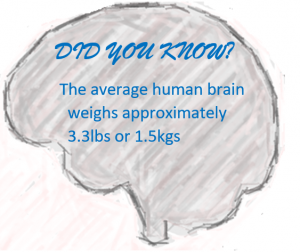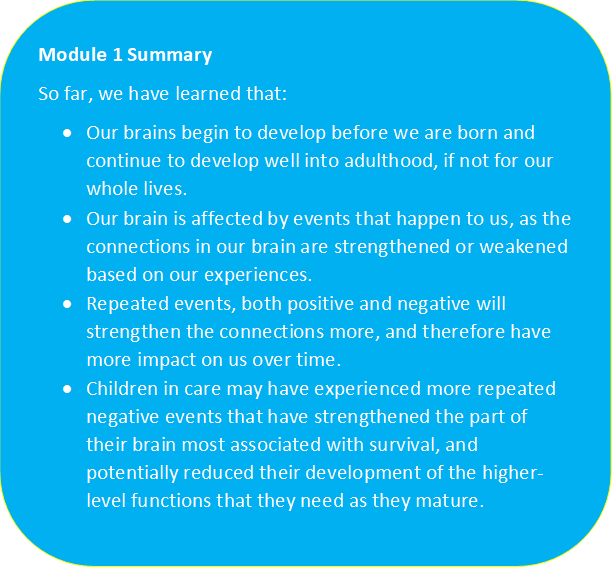Welcome to Module 1. Brain and Behaviour
In this module, we will explore some information about how the way our brains work might link to our behaviour. By the end of this module you should be able to understand the basic structures and systems of the areas of the brain and how they develop.
The Developing Brain
Our brains begin developing before we are born, in the first few days and weeks after conception, but in many ways they go on developing throughout our lives. When we are born our brain is quite generalised, that is we use our whole brain for most skills. As we grow and develop, parts of the brain become better connected and more specialised in completing particular skills. However, not all brains develop in exactly the same way – it’s part of what makes each of us unique.
This is because our experiences, from the moment we are born, define the way our brain develops and who we later become. What we think, what we remember, what we learn, and what we feel, are all acquired by the brain from the experiences around us.

Let’s look more closely at how this happens:
Early Life
Between the ages of 0-2-years, as we begin to explore the world, we come across new information, new concepts, and new objects on an almost daily basis. To go along with this, our brains are also making lots and lots of new connections, between cells in the brain called neurons, that carry this new information. From then on, until we are teenagers, our brains continue to create, develop and manage those connections to help us understand the world around us.
However, the world around us also shapes the way those connections develop. The connections that get used a lot become stronger and faster than those which we use less. The connections we don’t use and don’t need, fall away to make the connections that remain more efficient. So something that we do a lot, we get better and faster at doing, and the things we don’t practice or don’t need become redundant.
This video, produced by CNN helps to demonstrate this idea, watch it before moving on.
These processes support children’s brains to be more capable of learning, and being enriched by the world around them.
However, this can also mean children’s brains are more vulnerable to developmental problems if their environment does not support their development. This could be due to lack of nurturing, limited opportunities to learn, or adverse events. All of which are common in those who experience abuse, neglect or trauma in their early years.
Adolescence is a key period for brain development and this is often when we start to notice a difference in those who have had these kinds of experiences.

Adolescence
During adolescence the higher functioning areas of our brain begin to mature and become more involved in our day-to-day functioning. As we grow, we can therefore begin to function at different levels which each develop in turn. Consider the information below which explains these different levels more fully as they develop from early adolescence into early adulthood.
Putting it together
As you can see, managing our emotions is held in the limbic system and our biological responses, such as breathing and heart rate are held in the brain stem. This might mean that children who spend a lot of time feeling fearful or stressed, build stronger, faster connections in their brain stem and limbic system. Over time this means that they begin to feel more fear, more quickly, even in response to situations that might not seem that scary to others.
The focus on development in these areas can also reduce or delay the development of their cortex, and the higher brain functions supported by this level. You might think of this as the brain focusing more on surviving something difficult, than on developing other skills, such as those required for more complex thoughts and actions. Some of these more complex skills are called Executive Function, higher level skills we need to manage everyday life. In Module 2, we will consider these functions more closely.
Looking at the four lobes of the cortex, we can begin to see the kinds of skills which might be less developed when a child has faced adversity in their early life and adolescence. Click on each of the areas below to find out more.
Putting it together: A Case Example
Now let’s think about how this might affect some of the children in your care.
Meet Ben. Ben is 14, and he has been in the care system since the age of 8. His mother has problems with addiction and was known to binge on drugs and alcohol on and off throughout her pregnancy and Ben’s early life.
His father was also a drug user and he was often violent towards Ben’s mother and on occasion Ben himself, until Ben was taken into care. His parents’ relationship has since ended and he has no further contact with his father.
Ben’s paternal grandmother is a positive influence in his life, and he would spend weekends with her during his time at home. However, she did not feel she could provide full time care due to her own age and physical health, Ben still has contact with his grandmother once a week and they speak regularly by phone. He sees his mother once every month for supervised visits, which she does not always attend.
He did not attend school regularly under his mother’s care, but now attends the local mainstream school where he appears settled and is in the low average range of ability compared with his classmates. Ben’s first foster placement broke down when he was 11, as he became aggressive towards his foster siblings.
He has been in residential care ever since, and currently lives in a multibed care home with two other children.

In Module 2, we will look more closely at these high level functions, which collectively are known as Executive Functions. Click here when you are ready to continue
